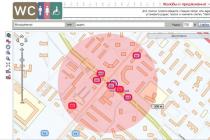The FOX series offers state-of-the-art solutions based on SDH / PDH primary network technologies, designed and tested for use in harsh environments. No other multiplexer solution provides such a wide range of specialized products - from teleprotection to Gigabit Ethernet using SDH technology and spectral division.
ABB pays special attention to the possibility of upgrading products to protect your investment and offers effective maintenance tools.
The complete communication solution of the FOX series consists of:
- FOX505: Compact access multiplexer with bandwidth up to STM-1.
- FOX515 / FOX615: Access multiplexer with up to STM-4 bandwidth for wide range operation user interfaces for data and voice transmission systems. The implementation of teleprotection functions and other features specific to a specific field of application ensure compliance with all requirements for access to data in the enterprise.
- FOX515H: Complementary to the FOX line and designed for high-speed communications.
- FOX660: Multi-service platform for data transmission systems.
All elements of the FOX515 series are controlled by FOXMAN, ABB's unified SNMP-based network management system. Its open architecture allows for integration with third-party management systems, both higher and lower levels. Graphical network display and point-and-click control makes the FOXMAN ideal solution for TDM and Ethernet management at the access and data transmission levels.
ETL600 R4 universal digital HF communication system
 ETL600 is a modern solution to the problem of providing HF communication over power lines for the transmission of voice signals, data and protection commands over high voltage lines. Versatile hardware architecture and software tools The ETL600 system makes the choice between traditional analog and future-proof digital RF equipment obsolete and obsolete. Using the same hardware components, the user can select digital or analog operating mode on site with just a few clicks of the mouse. In addition to ease of use, flexibility of use and unprecedented data transfer rates, the ETL600 system also guarantees unconditional compatibility with the existing technological environment and integrates well into modern digital communication infrastructures.
ETL600 is a modern solution to the problem of providing HF communication over power lines for the transmission of voice signals, data and protection commands over high voltage lines. Versatile hardware architecture and software tools The ETL600 system makes the choice between traditional analog and future-proof digital RF equipment obsolete and obsolete. Using the same hardware components, the user can select digital or analog operating mode on site with just a few clicks of the mouse. In addition to ease of use, flexibility of use and unprecedented data transfer rates, the ETL600 system also guarantees unconditional compatibility with the existing technological environment and integrates well into modern digital communication infrastructures.
User benefits
- An economical solution to the communication issue, ensuring reliable control and protection of the power system.
- Reduce costs through a common stock of hardware and spare parts for analog and digital HF transmission lines.
- Flexible architecture for easy integration into both traditional and modern equipment.
- Reliable transmission of protection signals
- Efficient use of limited frequency resources through flexible choice of transmission bandwidth.
- Fallback solution for selected mission-critical communications that are typically delivered over broadband communications
 Connection filter MCD80
Connection filter MCD80
Modular devices MCD80 are used to connect the leads of an RF communication device such as the ABB ETL600 via a capacitive voltage transformer to high-voltage lines.
The MCD80 filter provides optimal impedance matching for RF link output, frequency separation and safe isolation of 50/60 Hz mains frequency and transient voltages. It is configurable for single and multiphase communication with high pass filtering or bandwidth. MCD80 devices comply with the latest IEC and ANSI standards.
The main advantages of the MCD80 filters:
- Designed to work with any type of HF communication equipment
- The entire line of filters: broadband, bandpass, crossover, phase-to-phase and phase-to-earth
- Maximum possible choice of bandwidth (according to customer specification in 1kHz steps)
- Possibility of connection to both coupling capacitors and voltage transformers
- Wide range of connection capacities 1500pF-20000pF
- Possibility of rebuilding at the installation site when changing the connection capacitance within the operating range of capacities (for example, when replacing capacitors with voltage transformers)
- Low passband insertion loss (less than 1dB)
- Parallel connection of up to 9 terminals with a power of 80 W according to the phase-to-ground scheme and up to 10 terminals according to the phase-phase scheme is possible
- Integrated single pole disconnector (earthing switch)
 HF interceptors for VL-DLTC
HF interceptors for VL-DLTC
There are two types of DLTC surge arresters available for the protection of HF-type surge arresters.
Small and medium-sized HF tractors are equipped with standard ABB Polim-D surge arresters without arc arrestors.
Large arresters are equipped with ABB MVT arresters, which do not have an arc arrestor and are specially designed for use with ABB arresters. They use the same highly nonlinear metal oxide varistors (MO arresters) as station arresters.
The internal leakage of the MO restrictor is taken into account when designing the tuner. ABB Metal Oxide Surge Arresters are specially designed for use in the high electromagnetic fields that are often found in HF line interrupters. In particular, they do not contain unnecessary metal parts in which a magnetic field can induce eddy currents and cause an unacceptable increase in temperature. Modification of the metal oxide surge arresters for the operating conditions in line arresters was necessary because ABB manufactures such devices for stations and is fully aware of the problems that arise in practice. Surge arresters used in line arresters have a rated current of 10 kA.


Features and Benefits
Principal Advantages of DLTC HF Interceptors
Information from the site
The technological complex is designed to organize digital high-frequency channels: communications, TM, data transmission ASKUE, APCS and Ethernet over high-voltage power lines (6 - 10) kV.
The protection and matching system is designed to connect all types of channel-forming communication equipment, relay protection and PA to the HF path of the overhead line
Technological complex EPW9 is intended for the organization of digital and analog high-frequency channels: communications, TM, relay protection and automation equipment, PA, data transmission ASKUE, APCS and Ethernet over high-voltage power lines.
ET9 | DZ9 | CCP-4 | CSP-9 Organization of high-frequency communication over power lines
Technological complex ETT9 is intended for the organization of high-frequency communication channels, TM, relay protection and automation equipment, PA, data transmission ASKUE and APCS through high-voltage power lines.
High-frequency communication equipment
ESV6 connection filter
Connection filters are designed to connect HF communication equipment to air and cable overhead lines according to phase-to-earth or phase-to-phase schemes.
ET8 HF communication equipment for power lines
HF communication equipment for overhead lines of ET8 type makes it possible to organize from one to six reliable analog and digital communication channels in the frequency range from 20 to 1000 kHz.
ECS8 parameterization and diagnostic system
The ECS8 control system is designed for local and remote control(parameterization and diagnostics) with HF communication equipment of the PLC2000 family.
TG8 narrowband FSK modem
The G8 is a binary FSK modulation narrowband modem. Its use is a great solution for reliable data transmission over voice communication channels even under poor transmission conditions. The type of modulation applied (binary FSK) provides high immunity to interference and other influencing factors.
NF8 LF access terminal
LF access terminal NF8 provides simultaneous transmission of voice, call signals and telemechanics data, as well as teleprotection command signals in the range of tone frequencies from 300 Hz to 3720 Hz. The NF8 terminal provides the most efficient (both from a technical and economic point of view) use of the tone band.
DZ9 P3 command signal transmission device
The DZ9 device allows the transmission of up to 8 independent PZ commands over different digital channels communication and up to 4 independent RP commands via an analog communication channel. Channel coding and adaptive command detection algorithms guarantee optimal combinations of transmission time, security and reliability of command transmission in real transmission conditions.
DPA8 Device for transmitting PZ and PA commands
DPA8 is designed to transmit RP and PA signals over any analog voice channels, but maximum reliability and safety with a minimum signal transmission time is achieved when working through communication channels organized over overhead lines using ET8 equipment. DPA8 is a digital programmable device, the parameters of which make it possible to optimally adapt the devices and characteristics of the relay protection and PA commands in accordance with the requirements of protection systems and the wishes of consumers.
Optical transmission
SparkLight NG SDH STM 1/4/16 / xWDM
ADM-16 | ADM-4/1 | HSP
SparkLight is a new generation compact, powerful, high-density and easy-to-use SDH multiservice node for PCM (voice, data), PDH (E1, E3), SDH (STM-1, STM-4, STM-16) and Ethernet ( FE, GBE) via SDH.
Radio relay equipment
SparkWave
SDR HSP | SDR ADM | SDR STM | SDR GE | SDR AR
Multi-rate multifunctional radio relay node for new generation networks operating in the frequency range from 5 to 38 GHz.
Equipment SparkWave SDR HSP designed for radio relay transmission of PDH and Ethernet signals operating in the 5, 6, 7, 8, 11, 13, 15, 18, 23 and 26 GHz frequency bands.
Equipment SparkWave SDR ADM
Equipment SparkWave SDR STM-1 designed for radio relay transmission of STM-1 traffic operating in 5, 6, 7, 8, 11, 13, 15, 18, 23 and 26 GHz frequency bands.
Equipment SparkWave SDR GE is a high performance, easy-to-use split-mount, point-to-point wireless microwave radio link designed for applications Gigabit Ethernet large capacity.
SparkWave AR-18 / 23G the active repeater provides a very attractive solution for the 18/23 GHz radio path.
![]()
Energy Telecommunications
PowerLink
PowerLink HF communication system allows transmission of RP and PA signals, voice and data via high-voltage power lines. The technologies used in the development of the equipment fully comply with the latest standards and requirements of telecommunication systems ...
SWT 3000
By combining the capabilities of digital and analogue transmission in one device, the SWT 3000 forms a new class equipment. The main essential characteristics of an effective system are safety, reliability and command transmission time. The SWT 3000 system fully meets these requirements ...
Page 16 of 21
The design of the power transmission line, determined by its main purpose - the transmission of electrical energy over a distance, makes it possible to use it for the transmission of information. High level operation and high mechanical strength of the lines ensure the reliability of communication channels, close to the reliability of channels over cable lines communication. At the same time, when implementing communication channels over overhead lines for transmitting information, it is necessary to take into account the features of the lines that make it difficult to use them for communication purposes. Such a feature is, for example, the presence of substation equipment at the ends of the lines, which can be represented as a chain of reactance and active resistance connected in series over a wide range. These resistances form a connection between the overhead lines through the substation buses, which leads to an increase in the communication path. Therefore, to reduce the influence between the channels and attenuation, using special barriers, they block the paths of high-frequency currents towards the substations.
The attenuation of the branches from the overhead line also significantly increases. These and other features of the lines require the implementation of a number of measures to create conditions for the transmission of information.
The device of HF channels over 6-10 kV distribution networks is fraught with significant difficulties due to the specifics of the construction of networks of these voltages. On the sections of main lines 6-10 kV between neighboring switching points there are a large number of taps, the lines are sectioned by disconnectors and switches, the primary switching circuits of networks often change, including automatically, due to the greater damage to the lines of these voltages, their reliability is lower than B71 35 kV and above. Signal transmission in distribution networks depends on many factors affecting signal attenuation: the length and number of taps, line wire material, load, etc. The load can vary widely. At the same time, the disconnection of individual taps, as studies show, sometimes not only does not reduce the attenuation, but, on the contrary, increases it due to the violation of mutual compensation of attenuation between adjacent taps. Therefore, even small channels have significant attenuation and are unstable. The operation of the channels is also adversely affected by damage to the insulators, poor-quality wire connection and the unsatisfactory condition of the contacts of the switching equipment. These defects are sources of interference, commensurate with the level of the transmitted signal, which can cause the channel to stop working and damage the equipment. The presence of sectioning devices on the lines leads to a complete cessation of the operation of the HF channel in the event of their disconnection and grounding of one of the sections of the line. The noted disadvantages significantly limit, although they do not exclude, the use of 6-10 kV lines for organizing HF channels. Still, it should be noted that HF communication over distribution networks has not received widespread use at the present time.
By designation, high-frequency communication channels over power transmission lines are divided into four groups: dispatch communication channels, technological, special and linear operational communication channels.
Without dwelling in detail on the use and purpose of each group of channels, we note that for dispatching and technological channels telephone connection mainly used tone frequency band 300-3400 Hz<300-2300). Верхняя часть тонального спектра (2400-3400 Гц) не пользуется для передачи сигналов телеинформации. Современная комбинированная аппаратура позволяет организовать в этом спектре до четырех независимых узкополосных каналов телеииформации.
Line-operational communication channels are used to organize communication between the dispatcher and the repair crews working on the route of an extended power transmission line or substations, when there is no constant communication with them. For these channels, simplified transportable and portable telephone equipment is used.
According to the degree of complexity, HF channels are divided into simple and complex. Channels consisting of only two sets of RF terminal equipment are called simple. Complex channels include intermediate amplifiers or several sets of terminal equipment (at the same frequencies).
Equipment for high-frequency communication channels over overhead lines.
The connection of the communication equipment to the wires of the power transmission line is carried out using special devices, the so-called equipment for connecting and processing the line, consisting of a coupling capacitor, a trap and protection elements.
Rice. 21. Scheme of a high-frequency communication channel for overhead lines
In fig. 21 shows a diagram of the formation of a communication channel over the overhead line. Signal transmission by high-frequency currents is carried out by the transmitters of the compaction equipment J, located at both ends of the overhead line at substations A and B.
Here, in the composition of the compaction equipment 1, there are receivers that receive modulated RF currents and convert them. To ensure the transmission of signal energy by HF currents through the wires, it is sufficient to process one wire at each end of the line using a trap 5, a coupling capacitor 4 and a connection filter 3, which is connected to the sealing equipment 1 using an HF cable 2. To ensure the safety of personnel working on the connection filter when the RF channel is operating, the grounding knife is used 6.
Connecting high-frequency equipment according to the diagram in Fig. 21 is called phase-to-earth. Such a scheme can be used to form single-channel and multi-channel information transmission systems. Other connection schemes are also used.
If it is necessary to connect the equipment installed on the line route to the power transmission line (mobile telephone equipment of repair crews, equipment of a remotely controlled VHF radio station, etc.), as a rule, antenna connection devices are used. Sections of insulated wire of a certain length or sections of a lightning protection cable are used as an antenna.
A high-frequency (linear) trap has a high resistance for the operating frequency of the channel and serves to block the path of these currents, reducing their leakage towards the substation. In the absence of a suppressor, the channel attenuation may increase, since a small input impedance of the substation shunts the RF channel. The trap consists of a power coil (reactor), a setting element and a protection device. The power coil is the main element of the minelayer. It must withstand the maximum operating line currents and short-circuit currents. The power coil is made of coiled copper or aluminum wires of the appropriate cross-section, wound on wood-laminated plastic (delta-wood) or fiberglass rails. The ends of the rails are fixed on metal crosspieces. A setting element with protective arresters is attached to the upper crosspiece. The tuning element is used to obtain a relatively high resistance of the trap at one or several frequencies or frequency bands.
The tuning element consists of capacitors, inductors and resistors and is connected in parallel
power coil. The power coil and setting element of the trap are exposed to atmospheric and switching overvoltages and short-circuits. The role of overvoltage protection, as a rule, is performed by a valve arrester consisting of a spark gap and a non-linear power resistor.
In electrical networks of 6-220 kV, minelayers VZ-600-0.25 and KZ-500, as well as minelayers with a steel core of the VChZS-100 and VChZS-100V types, differing from each other in rated current and inductance, stability and geometric parameters power coil, as well as the type of setting element and its protection.
The arresters cut into the phase conductor of the power line between the line disconnector and the coupling capacitor. High-frequency traps can be mounted suspended, on supporting structures, including coupling capacitors.
Coupling capacitors are used to connect HF equipment to the overhead line, while the power frequency leakage currents are diverted through the coupling capacitor to ground, bypassing the high frequency equipment. Coupling capacitors are designed for phase voltage (in a network with a grounded neutral) and for a line voltage (in a network with an isolated neutral). In our country, two types of coupling capacitors are produced: СМР (communication, oil-filled, with an expander) and SMM (communication, oil-filled, in a metal case). For different voltages, capacitors are assembled from individual elements connected in series. Coupling capacitors can be installed on reinforced concrete or metal supports with a height of about 3 m. To isolate the lower element of the СМР condenser from the support body, special porcelain supports with a circular cross section are used.
The coupling filter serves as a link between the coupling capacitor and the RF equipment, separating the high voltage line and the low current setting, which is the sealing equipment. The connection filter thus ensures the safety of personnel and protection of the equipment from high voltage, since when the lower plate of the coupling capacitor is grounded, a path is formed for leakage currents of industrial frequency. With the help of the connection filter, the wave impedances of the line and the high-frequency cable are matched, as well as the compensation of the reactance of the coupling capacitor in a given frequency band. Connection filters are made according to transformer and autotransformer circuits and together with coupling capacitors form band-pass filters.
The most widespread in the organization of high-frequency communication channels through the power transmission lines of the enterprise is the connection filter of the OFP-4 type (see Fig. 19). The filter is enclosed in a steel welded casing with a bushing for connecting a coupling capacitor and a cable funnel for entering an RF cable. An arrester is mounted on the wall of the housing, which has an elongated pin for connecting the grounding bus and is designed to protect the connection filter elements from overvoltage. The filter is designed for connecting RF equipment according to the phase-to-ground scheme, complete with coupling capacitors with a capacity of 1100 and 2200 pF. The filter is installed, as a rule, on the support of the coupling capacitor and is bolted to the support at a height of 1.6-1.8 m from the ground level.
As noted, all switchings in the connection filter circuits are performed with the grounding knife turned on, which serves to ground the lower plate of the coupling capacitor during the work of personnel. A single-pole disconnector for voltage 6-10 kV is used as a grounding knife. Operations with the grounding knife are carried out using an insulating rod. Some types of connection filters have an earthing knife mounted inside the housing. For safety reasons, a freestanding earthing blade must be installed in this case.
The high-frequency cable is used for electrical connection of the connection filter (see Fig. 21) with the transceiver equipment. When connecting the equipment to the line according to the phase - earth scheme, coaxial cables are used. The most common is a high-frequency coaxial cable of the RK-75 brand, the inner conductor (single-core or multi-core) of which is separated from the outer braid by high-frequency dielectric insulation. The outer braided shield serves as a return conductor. The outer conductor is enclosed in a protective insulating sheath.
The high-frequency characteristics of the RK-75 cable, like ordinary communication cables, are determined by the same parameters: wave impedance, kilometric attenuation and the speed of propagation of electromagnetic waves.
Reliable operation of HF channels on overhead lines is ensured by high-quality and regular performance of scheduled preventive work, which provides for a whole range of work on the equipment of HF communication channels over overhead lines. To perform preventive measurements, the channels are taken out of service. Preventive maintenance includes scheduled checks of equipment and channels, the frequency of which is determined by the condition of the equipment, the quality of maintenance, taking into account preventive maintenance, and is set at least once every 3 years. Unscheduled channel checks are performed when the RF path is changed, equipment is damaged, and when the channel is unreliable due to violation of the regulated parameters.
Third
Second
First
Transformer protection circuit, in which there is differential and gas protection (DZ), responding to the disconnection of the transformer on both sides and the maximum current protection (SZ), which should disconnect only on one side.
When drawing up a schematic diagram of relay protection in a minimized form, the electrical connection of the tripping circuits of two switches may not be detected. From the expanded scheme (Scheme 1) it follows that with such a connection (cross-circuit), a false circuit is inevitable. Two auxiliary contacts are required at the protective relays (Diagram 2) acting on two switches or an isolating intermediate relay (Diagram 3).
Rice. - Transformer protection circuit: 1 - wrong; 2,3 - correct
Unseparated high and low voltage circuits transformer.
Figure (1) shows the impossibility of independently disconnecting one of the sides of the transformer without disconnecting the other.
This situation is corrected by turning on the intermediate relay KL.
Rice. - Transformer protection circuits: 1 - wrong; 2 - correct
The protections of the generator and transformer of the unit at the power plant act, as required, to turn off the circuit breaker and the field extinguishing circuit breaker through the separating intermediate relays KL1 and KL2, but the relays are connected to different sections of the power bus, i.e. through different fuses.
The false circuit, shown by the arrows, was generated through the HL fuse control lamp due to blown fuse FU2.
Rice. - Formation of a false circuit when a fuse blows
1, 2, 3 - relay contacts
Circuits with power supply of circuits of secondary connections with operational direct and alternating current
When the poles of the power supply are well isolated from earth, an earth fault at one point in the secondary circuit is usually not harmful. However, a second earth fault can cause false activation or deactivation, incorrect alarms, etc. Preventive measures in this case can be:
a) signaling of the first earth fault in one of the poles; b) two-pole (two-way) separation of control circuit elements - practically not used due to complexity.
With insulated poles (Fig.), Grounding at a with open NO contacts 1 will not yet cause a false action of the coil of the command body K, but as soon as a second insulation fault to ground appears in the branched network of the positive pole, false operation of the apparatus is inevitable, since the contact 1 turns out to be shunted. That is why a ground fault signaling is necessary in the operating circuits, and above all at the poles of the power supply.
Rice. - False operation of the device at the second earth fault
However, in complex circuits with a large number of operational contacts connected in series, such an alarm may not detect an earth fault that has occurred (Fig.).
Rice. - Ineffectiveness of insulation monitoring in complex circuits
When grounding appears between the contacts at the point a signaling is not possible.
In the practice of operating automatic installations with low-current equipment (up to 60 V), they sometimes resort to deliberate grounding of one of the poles, for example, the positive one (it becomes more dusty and susceptible to electrolytic phenomena, i.e., it already has weakened insulation). This facilitates the detection and elimination of the emergency source. In this case, it is recommended to connect the control circuit coil at one end to the pole that is grounded.
All that has been said about the supply of circuits with a direct operating current can be attributed to the operating alternating current with supply of circuits with a linear voltage. In this case, the likelihood of false operation (due to capacitive currents) and resonance phenomena should be taken into account. Since it is difficult to provide conditions for reliable operation in this case, sometimes auxiliary isolating intermediate transformers are used with grounding of one of the terminals on the secondary side.
As can be seen from the diagram, in this case, if the insulation to ground at point 2 is damaged, the fuse FU1 blows and an earth fault at point 1 does not cause a false switch on of the contactor K.
Connection diagram of capacitors with isolation diodes
High-frequency (HF) communication over high voltage lines has become widespread in all countries. In Ukraine, this type of communication is widely used in power systems to transmit information of a different nature. High-frequency channels are used for transmission of signals for relay protection of lines, tele-disconnection of switches, remote signaling, telecontrol, telecontrol and telemetry, for dispatching and administrative telephone communications, as well as for data transmission.
Communication channels through power transmission lines are cheaper and more reliable than channels through special wire lines, since no funds are spent on the construction and operation of the communication line itself, and the reliability of the power transmission line is much higher than the reliability of conventional wire lines. The implementation of high-frequency communication over power lines is associated with features that are not found in wire communication.
To connect the communication equipment to the wires of the power transmission lines, special processing and connection devices are required to separate the high voltage from the low-current equipment and implement a path for transmitting HF signals (Fig. 1).
Rice. - Connection of high-frequency communication equipment to high voltage lines
One of the main elements of the circuit for connecting communication equipment to power lines is a high voltage coupling capacitor. The coupling capacitor, connected to full mains voltage, must have sufficient electrical strength. For a better matching of the input resistance of the line and the connecting device, the capacitance of the capacitor must be large enough. Coupling capacitors produced now make it possible to have a connection capacity on lines of any voltage class not less than 3000 pF, which makes it possible to obtain connection devices with satisfactory parameters. The coupling capacitor is connected to the coupling filter, which grounds the lower plate of this capacitor for power frequency currents. For high-frequency currents, the coupling filter together with the coupling capacitor matches the resistance of the high-frequency cable with the input resistance of the power line and forms a filter for transferring high-frequency currents from the high-frequency cable to the line with low losses. In most cases, a coupling filter with a coupling capacitor forms a band-pass filter circuit that passes a certain frequency band.
The high-frequency current, passing through the coupling capacitor along the primary winding of the connection filter to ground, induces a voltage in the L2 secondary winding, which through the capacitor C1 and the connecting line enters the input of the communication equipment. The power frequency current passing through the coupling capacitor is small (from tens to hundreds of milliamperes), and the voltage drop across the coupling filter winding does not exceed several volts. In the event of an open or poor contact in the connection filter circuit, it may be under the full voltage of the line, and therefore, for safety reasons, all work on the filter is performed when the lower plate of the capacitor is grounded with a special grounding knife.
By matching the input impedance of the HF communication equipment and the line, the minimum energy loss of the HF signal is achieved. Matching with an overhead line (OHL) with a resistance of 300-450 Ohm is not always possible to complete completely, since with a limited capacitance of the coupling capacitor, a filter with a characteristic impedance on the side of the line equal to the characteristic impedance of the overhead line can have a narrow bandwidth. In order to obtain the necessary bandwidth, in some cases it is necessary to admit an increased (up to 2 times) characteristic impedance of the filter on the side of the line, reconciling with somewhat larger losses due to reflection. The connection filter, installed at the coupling capacitor, is connected to the equipment with a high-frequency cable. Several high-frequency devices can be connected to one cable. To weaken the mutual influences between them, crossover filters are used.
Channels of system automation - relay protection and interconnection, which must be especially reliable, require the mandatory use of crossover filters to separate other communication channels operating through a common connection device.
To separate the HF signal transmission path from the substation high voltage equipment, which may have a low resistance for high frequencies of the communication channel, a high frequency trap is connected to the phase conductor of the high voltage line. The high-frequency trap consists of a power coil (reactor), through which the operating current of the line passes, and a tuning element connected in parallel with the coil. The power coil of the minelayer with a tuning element form a two-pole, which has a sufficiently high resistance at operating frequencies. For a power frequency of 50 Hz, the trap has a very low resistance. The minelayers are used, designed to block one or two narrow bands (one- and two-frequency minelayers) and one wide frequency band of tens and hundreds of kilohertz (broadband minelayers). The latter are most widespread, despite the lower resistance in the obstacle strip compared to single and dual-frequency ones. These barriers make it possible to block the frequencies of several communication channels connected to the same line wire. The higher the resistance of the trap in a wide frequency band can be provided the easier, the greater the inductance of the reactor. It is difficult to obtain a reactor with an inductance of several millihenries, since this leads to a significant increase in the size, weight and cost of the minelayer. If the active resistance in the band of cut-off frequencies is limited to 500–800 Ohm, which is sufficient for most channels, then the inductance of the power coil can be no more than 2 mH.
The trap is produced with an inductance of 0.25 to 1.2 mH for operating currents from 100 to 2000 A. The operating current of the trap is the higher, the higher the line voltage. For distribution networks, minelayers are produced for 100-300 A, and for 330 kV lines and above, the maximum operating current of the minelayer is 2000 A.
Various tuning circuits and the required range of cut-off frequencies are obtained using capacitors, additional inductors and resistors available in the trap tuner tuning element.
Connection to the line can be done in various ways. With an unbalanced circuit, HF equipment is connected between a wire (or several wires) and ground according to the "phase-to-earth" or "two-phase-to-earth" circuits. With symmetrical circuits, HF equipment is connected between two or more wires of the lines ("phase - phase", "phase - two phases"). In practice, the "phase-phase" scheme is used. When you turn on the equipment between the wires of different lines, only the "phase-phase of different lines" scheme is used.
To organize HF channels along high voltage lines, a frequency range of 18–600 kHz is used. In distribution networks, frequencies ranging from 18 kHz are used, on trunk lines 40–600 kHz. To obtain satisfactory parameters of the HF path at low frequencies, large values of the inductances of the power trap coils and the capacitances of the coupling capacitors are required. Therefore, the lower frequency limit is limited by the parameters of the processing and connection devices. The upper limit of the frequency range is determined by the acceptable value of the linear attenuation, which increases with increasing frequency.
1. HIGH FREQUENCY PROTECTORS
Tunnel configuration schemes... High-frequency traps have a high resistance for the currents of the operating frequency of the channel and serve to separate the elements shunting the HF path (substations and branches), which, in the absence of traps, can lead to an increase in the attenuation of the path.
The high-frequency properties of the trap are characterized by an obstacle band, i.e., a frequency band in which the trap resistance is not less than a certain permissible value (usually 500 Ohm). As a rule, the barrage is determined by the permissible value of the active component of the resistance of the trap, but sometimes by the permissible value of the impedance.
The barriers differ in the values of the inductances, the permissible currents of the power coils and in the tuning schemes. One- and two-frequency resonant or blunted tuning circuits and broadband circuits are used (according to the full-link and half-link of the band-pass filter, as well as according to the half-link of the high-pass filter). Suppressors with single- and dual-frequency tuning schemes often do not provide an opportunity to block the desired frequency band. In these cases, minelayers with broadband tuning schemes are used. Such adjustment schemes are used when organizing protection and communication channels that have a common connection equipment.
When current flows through the coil of the trap, electrodynamic forces arise, acting along the axis of the coil, and radial, tending to break the coil. The axial forces are uneven along the length of the coil. Great forces are generated at the edges of the coil. Therefore, the step of the turns at the edge is made larger.
The electrodynamic resistance of the minelayer is determined by the maximum short-circuit current that it can withstand. In the KZ-500 minelayer at a current of 35 kA, axial forces of 7 tons (70 kN) arise.
Overvoltage protection of setting elements... An overvoltage wave that occurs on the overhead line hits the trap. The wave voltage is distributed between the tuner capacitors and the input impedance of the substation busbars. The power coil is a large impedance for a steep wave front and can be ignored when considering overvoltage processes. To protect the tuning capacitors and the power coil, an arrester is connected in parallel to the power coil, which limits the voltage on the elements of the trap to a value that is safe for them. The breakdown voltage of the spark gap, according to the conditions of deionization of the spark gap, should be 2 times higher than the accompanying voltage, i.e., the voltage drop across the power coil from the maximum short-circuit current U res = I short-circuit. ωL.
With a long pre-discharge time, the breakdown voltage of the capacitors is much higher than the breakdown voltage of the arresters; at low (less than 0.1 μs), the breakdown voltage of the capacitors becomes less than the breakdown voltage of the spark gap. Therefore, it is necessary to delay the increase in the voltage across the capacitors until the spark gap is triggered, which is achieved by connecting an additional inductor L d in series with the capacitor (Fig. 15). After the breakdown of the spark gap, the voltage across the capacitor rises slowly and an additional spark gap connected in parallel with the capacitor protects it well.
Rice. - High-frequency minelayer circuits with overvoltage protection device: a) single-frequency; b) dual-frequency
2. COUPLING CAPACITORS
General information... Coupling capacitors are used to connect HF communication equipment, telemechanics and protection to high voltage lines, as well as for power take-off and voltage measurement.
The resistance of a capacitor is inversely proportional to the frequency of the voltage applied to it and the capacitance of the capacitor. The reactance of the coupling capacitor for power frequency currents, therefore, is significantly higher than for the frequency of 50 - 600 kHz of telemechanics and protection communication channels (1000 times or more), which allows using these capacitors to separate high and power frequency currents and prevent the ingress of high voltage on electrical installations. Power-frequency currents are diverted to ground through coupling capacitors, bypassing the HF equipment. Coupling capacitors are designed for phase (in a network with a grounded neutral) and line voltage (in a network with an isolated neutral).
For power take-off, special take-off capacitors are used, connected in series with a coupling capacitor.
In the names of capacitor elements, the letters denote sequentially the nature of the application, the type of filler, design; numbers - rated phase voltage and capacity. СМР - connections, oil-filled, with an expander; SMM - ties, oil-filled, in a metal casing. Coupling capacitors for different voltages are composed of individual elements connected in series. Elements of capacitors СМР-55 / √3-0.0044 are designed for normal operation at a voltage of 1.1 U uhm, elements СМР-133 / √3-0.0186 - for 1.2 U uhm. The capacitance of capacitors for insulation classes 110, 154, 220, 440 and 500 kV is accepted with a tolerance of -5 to + 10%.
3. CONNECTION FILTERS
General information and calculated dependencies. High-frequency equipment is connected to the capacitor not directly through the cable, but through a connection filter, which compensates for the reactance of the capacitor, matches the wave impedances of the line and the high-frequency cable, ground the lower plate of the capacitor, which forms a path for industrial frequency currents and ensures the safety of work.
When the linear winding circuit of the filter is broken, a phase voltage appears with respect to the ground on the lower plate of the capacitor. Therefore, all switches in the linear winding circuit of the connection filter are performed with the grounding knife turned on.
The OFP-4 filter (Fig.,) Is designed to operate on 35, 110 and 220 kV lines according to the "phase-to-ground" scheme with a coupling capacitor of 1100 and 2200 pF and with a cable having a characteristic impedance of 100 Ohm. The filter has three frequency ranges. There is a separate air-filled transformer for each range, which is filled with insulating compound.
Rice. - Schematic diagram of the OFP-4 filter-connection
6. PROCESSING OF LIGHTNING PROTECTION CABLES, ANTENNAS
Lightning protection cables of high voltage lines can also be used as information transmission channels. The cables are isolated from the supports in order to save energy; in case of atmospheric overvoltages, they are grounded through breakdown spark gaps. Steel cables have a high attenuation for high frequency signals and allow information to be transmitted only on short lines at frequencies not exceeding 100 kHz. Bimetallic cables (steel cables with aluminum coating), alumoveld cables (made of twisted steel-aluminum wires), single-thread cables (one layer - aluminum wires, the rest - steel ones) make it possible to organize communication channels with low attenuation and noise levels. The interference is less than in the communication channels along the phase wires, and the equipment for HF processing and connection is simpler and cheaper, since the currents flowing through the cables and the voltages on them are small. Bimetallic wires are more expensive than steel ones, so their use can be justified if HF channels on phase wires cannot be made. This can be on ultra-long-distance, and sometimes on long-distance power transmissions.
The cable channels can be switched on according to the "cable - cable", "cable - ground" and "two cables - ground" schemes. On AC overhead lines, the cables are interchanged every 30 - 50 km to reduce the induction of industrial frequency currents in them, which introduces an additional attenuation of 0.15 Np for each crossing in the "cable-cable" schemes, without affecting the "two cables - Earth". On DC transmissions, the cable-to-cable scheme can be used, since crossing is not necessary here.
Communication via lightning protection cables is not interrupted when the phase conductors are grounded, and does not depend on the line commutation scheme.
Antenna communication is used to connect mobile HF equipment to the overhead line. The wire is suspended along the wires of the overhead line or a section of the lightning protection cable is used. Such an economical way of connection does not require suppressors and coupling capacitors.
Government "HF communication" during the Great Patriotic War
P. N. Voronin
Government communication plays an important role in the management of the state, its Armed Forces, in social, political and economic life. Its foundation was laid in 1918, when the Soviet Government moved to Moscow. Initially, a manual switch for 25 numbers was installed in Moscow, then it was expanded and subsequently replaced with an automatic telephone exchange.
Long-distance government communication (in memoirs and works of art it is called "high-frequency communication") was organized in the 30s as an operational communication of the state security agencies. It ensured a certain secrecy of the negotiations, and therefore the heads of the highest governing bodies of the state and the Armed Forces also became its subscribers. In May 1941, by order of the Council of People's Commissars of the USSR, this connection was defined as "Government high-frequency communication" and the corresponding "Regulations" were approved. In accordance with the accepted terminology, "HF communication" can be attributed to one of the secondary EASC networks and must meet additional requirements for the protection of transmitted information, reliability and survivability. However, it was not possible to fully implement these requirements before the start of the Great Patriotic War. As a means of command and control of the Armed Forces in a combat situation, HF communications turned out to be unprepared.
The complication of the situation at the beginning of 1941 was felt by the increasing number of assignments for organizing high-frequency communications for large formations and formations of the Red Army in the border zone. The night of June 21-22 caught me doing one of these tasks. At about 4 o'clock in the morning, a technician on duty from Brest called and said that the Germans had begun shelling the city. The evacuation began. What to do with the equipment of the HF station? It was instructed to contact the local leadership and act on their instructions, but under all conditions, dismantle and remove the classified equipment. Then such calls came from Bialystok, Grodno and other cities along the western border. So the war began, which immediately posed a number of urgent tasks.
In view of the possible bombing of Moscow by the enemy, it was necessary to urgently move the Moscow HF station to a protected room. A room was allocated on the Kirovskaya metro platform. The station was closed to passengers. Installation was carried out on its own. The work was complicated by the fact that it was necessary to transfer the operating equipment without interrupting the work of the HF station. We did not have any backup equipment.
Similar work was carried out by the People's Commissariat of Communications (NK). The telegraph equipment, the intercity station was moved to protected premises. The work was headed by I.S.Ravich (at that time the head of the Central Directorate of Main Communications). We worked closely with him. The channels required for HF communication were supposed to be received only from protected NK communication nodes.
The general unpreparedness of the means of communication for war immediately affected. The entire network of the country was based on air lines, extremely exposed to the influence of climatic conditions, and with the deployment of hostilities and destruction by the enemy both by air bombing and by sabotage groups. The Germans even used special bombs "with hooks" to destroy multi-wire communication lines. Falling, such a bomb hooked on the wires and exploded, destroying the entire bundle of wires at once.
There were also serious shortcomings in the construction of the used long-distance communication network. It was created on a strictly radial principle. There were no ring communication lines and bypass routes, no reserve communication centers were prepared, protected from enemy bombing, even the main long-distance routes to Moscow were not ringed. In the event of the destruction of one of them, it was impossible to switch the communication lines to another direction. The NK Communications made a decision on the urgent construction in September 1941 of a bypass ring communication line around Moscow along the Lyubertsy - Khimki - Pushkino - Chertanovo route. In 1941 it was a ring about 20 km from Moscow. NK Communications carried out other work to improve the reliability of the long-distance network.
The task was set to provide high-frequency communication with the fronts, and after the battle of Moscow - with the armies. A number of questions immediately arose and, first of all, who would build communication lines and operate them, how to provide front-line HF stations with communication equipment - compaction equipment, switches, batteries, classified communication equipment (LAS) and other equipment adapted to work in the field ...
The first question was resolved quickly. The State Defense Committee (GKO) ordered the NK of Communications and the NK of Defense to build and maintain lines of Government communications. But, as experience has shown, this was not the best solution. NK communications for the maintenance of the lines had overseers - one for tens of kilometers. With massive damage to air lines as a result of hostilities, air bombings and destruction by enemy sabotage groups, it was physically impossible to quickly eliminate the damage and ensure uninterrupted operation of communications.
Defense NK signalmen were busy maintaining the lines of command and control and also could not focus on the lines of Government communications. As a result, the Government communication at some moments worked unstable, which led to fair complaints from subscribers. After each complaint, analysis began, the reasons were clarified, and recriminations began. Who is guilty? The matter reached the top leadership of the NKVD, NK communications and NK defense. A fundamental solution to this issue was needed.
In the department of the NKVD government high-frequency communications, it was decided to create a line-operational service, for which to form 10 line-operational companies, then another 35. Government communications began to work more steadily. But already during the battle of Moscow, when our troops began to attack and the headquarters of the fronts and armies went forward, difficulties arose with the construction of communication lines.
This issue became especially acute in 1942, when the Germans approached the Volga and began to surround Stalingrad. I remember one of the autumn evenings of 1942. The Germans were furiously rushing to the city. The battles took place on the near approaches. The front headquarters was located in a shelter on the right bank of the Volga. Communication with the front was interrupted due to the intensified bombing of communication lines. The line units of the Government Liaison made heroic efforts to restore the lines, but the enemy bombed, and the connection was again disrupted. Bypass lines have also been violated. At this time, JV Stalin needed a connection with the Stalingrad Front. A. N. Poskrebyshev, Stalin's assistant, called me and asked what to report to him - when there would be a connection. I answered - in 2 hours (in the hope that during this time it will be possible to restore the line). I contacted our unit and received a reply that the bombing had intensified. He gave the command to make a "temporary hut" - to lay the PTF-7 field cable on the ground. Poskrebyshev called again 2 hours later. I informed him that it would take another 40 minutes. After 40 minutes, Poskrebyshev offered to personally report to Stalin when there would be a connection. But at this time the line was restored. Stalin spoke with the headquarters, and a personal report was not required. Soon the People's Commissar of Internal Affairs Beria and the Deputy People's Commissar of Defense, the People's Commissar of Communications IT Peresypkin, were summoned to Stalin. Stalin expressed great displeasure that there was no stable connection with Stalingrad and recalled that as early as 1918 he had a reliable connection with Lenin while on the Tsaritsyn front.
It was instructed to submit proposals providing for the responsibility of one body for the unconditional reliability of the operation of communications. Such proposals have been developed. The GKO decree was issued on January 30, 1943. The government communications troops were created, whose task was to ensure the construction, maintenance and military protection of the government communications lines from the Headquarters of the Supreme High Command to the fronts and armies. Other lines running through the territory of the country to the republics, territories and regions, used for government communications, remained in the service of the NK communications.
In the NKVD, the Office of the Government Communications Troops was created. It was headed by P.F. The head of the line service in the Department of Government Communications K. A. Aleksandrov, a major line specialist, became his deputy. At the fronts, Departments of Government Communications were created, which were subordinate to the units of the troops of the Government Communications - separate regiments, battalions, companies. It seems somewhat strange the decision to create in the NKVD two divisions in charge of Government communications - the Department and the Directorate of Troops. However, this was dictated by the specifics of the work of the state security agencies: there were operational units and troops performing specific military tasks at the direction of the operational agencies.
Like this structure, the NKVD had an operational body - the Department of Government Communications, which was in charge of the organization of communications, its development, technical equipment, station service, issues of maintaining secrecy - and troops that built communication lines, ensured their uninterrupted operation and were guarded by paired outfits and secret ambushes in vulnerable places, excluding the possibility of connecting to the lines for eavesdropping, suppressed possible sabotage.
The department and the Directorate of Troops worked in close contact throughout the war, and there were no misunderstandings in their relationship. They merged in 1959; the structure of the Government Liaison has received its logical conclusion. The bodies and troops were able to comprehensively carry out the tasks of organizing and maintaining communications in difficult conditions of a combat situation.
Communication was organized along "axes" and directions. The center line was pulled to the front headquarters. As a rule, they tried to build two center lines along different routes, a direction was laid to the armies - one communication line. Two circuits were suspended from it: one was sealed by HF equipment, and the other, a service one, was intended for communication with service posts.
On the army lines, during the construction of communication lines, we often contacted the signalmen of the NK defense. They pulled one line, which was used for compaction, and the "midpoint" was handed over to army signalmen for telegraph communication on the Baudot system. HF communications were organized at the main command post (CP), reserve (ZKP) and forward (PKP) points. When the front commander left for the troops, he was accompanied by an officer of the Government Liaison with the ZAS equipment. HF communications were organized at the location of the commander, taking into account the available army communication lines or NK communication lines.
The government communications troops received their baptism of fire in the battle on the Oryol-Kursk Bulge, where five fronts operated simultaneously and several dozen HF stations were deployed. Signalers successfully coped with the assigned tasks, ensuring uninterrupted communication of the Headquarters with all the fronts, armies and two representatives of the Headquarters -G. K. Zhukov and A. M. Vasilevsky, who had their own HF stations.
After the Oryol-Kursk battle, the troops began a rapid offensive, liberating our territories from the German invaders. The offensive speed of combined arms armies reached 10-15 km per day, and tank armies - up to 20-30 km. At such a pace, the troops did not have time to build permanent air lines. It was necessary to arm them with the so-called cable-pole lines, which were deployed during the rapid advance of the troops as temporary and were subsequently replaced by permanent ones, if it was required to maintain this direction. This is how the line service was created.
The issues of technical equipment of front-line and army high-frequency communication stations were also resolved. In the Government Communications, for the organization of high-frequency channels, the multiplexing system in the 10-40 kHz spectrum of the SMT-34 type adopted at that time on the long-distance NK communications network was used. It was purely stationary equipment. The racks were 2.5 m high and weighed more than 400 kg. On a car, the rack could be transported by laying it on its side. She could not stand any shaking. Often, after transportation, it was necessary to restore the installation for days. There were also no switches, batteries, block stations and other equipment adapted to the field conditions. Everything had to be created anew.
The only base for the production of long-distance communications equipment at that time was a workshop at the Krasnaya Zarya plant in Leningrad. But by the end of 1941, Leningrad was in a blockade. Emergency measures were taken to evacuate this workshop to Ufa, where plant No. 697 for the production of long-distance communication equipment and a research institute were established.
Thanks to the hard work of teams headed by prominent specialists A, E. Pleshakov and M.N. 60 cm, weight 50 kg). It was convenient for the rapid deployment and dismantling of HF stations, and withstood shaking during transportation. The NHFT equipment was also developed in the spectrum up to 10 kHz and the fourth channel was added to the CMT equipment in the spectrum over 40 kHz, switches and ZAS equipment were created in field performance. For the creation of this complex, the authors were awarded the State Prize. Government communications received a complete set of communications equipment in field performance, which made it possible to quickly resolve issues of organizing high-frequency communications.
An attempt was made to reserve wire communication with the fronts by radio communication. At that time, only the KB band could be used for radio communication. The RAF and PAT stations produced by the industry were taken. But they did not find wide application. The ZAS equipment used on radio channels made high demands on the quality of the channel, which was difficult to achieve on HF lines. In addition, the subscribers, who were warned that they were provided with communication by radio, often refused to speak. I remember such a case. After the end of the war, a peace conference was held in Paris. The Soviet delegation was headed by VM Molotov. We organized a wired connection to Berlin via our own communication lines, and from Berlin to Paris the line was provided by the Americans. While we were having open conversations, the connection worked perfectly, as soon as the ZAS was turned on, the connection was terminated. We also provided for a radio reservation using stationary radio communications of the NK communication. But Molotov refused to speak on the radio, saying that he had to recognize the subscriber with whom he was speaking by his voice. With the ZAS equipment that was used, this was difficult to achieve. I had to quarrel with the Americans and achieve stable operation of wire communication.
The characteristics of the activities of the Government Communications during the Great Patriotic War will not be complete, if not dwell on some of the most significant operations and events.
When at the end of 1941 Leningrad was blockaded by the Germans, the question of high-frequency communication with the Leningrad front and the city arose. NK Communications organized communication by radio. We could not use this connection due to the lack of appropriate ZAS equipment. We needed a wire line. The communications NK and the Defense NK decided to urgently lay a cable in the only possible direction - along the bottom of Lake Ladoga. The laying was carried out under enemy fire. As a result, a wire connection was organized via "air" with Leningrad through Vologda to Tikhvin, then by cable to Vsevolozhskaya, then again by air to Leningrad. The headquarters had a stable high-frequency connection with Leningrad throughout the war.
By the summer of 1942, the Germans had recovered from the defeat near Moscow, an offensive began in the southern direction. The Voronezh Front was created. I flew with a group of employees to Povorino, where the headquarters of the Voronezh Front was to move. Soon the first deputy commissar of communications A.A.Konyukhov arrived there. We launched work on assembling nodes and organizing communications. The Germans bombed Povorino every day. During the bombing, we hid in a nearby ravine, and then continued work again. But one day, returning from the hiding place, we saw the dying debris of the buildings where we placed our nodes. All equipment was also lost. There were "claws" and a telephone set. We climbed onto the lead-in post with preserved wires. A. A. Konyukhov and I reported to our leaders about the incident. But by this time the situation had changed and HF communications were deployed in the village of Otradnoye, where the front headquarters soon moved. Soon I was ordered to urgently leave for Stalingrad.
A very difficult situation developed in Stalingrad. All the main lines of communication between Moscow and Stalingrad went along the right bank of the Volga. After the Germans came ashore above Stalingrad, in the town of Rynok, and below Stalingrad, in the Krasnoarmeisk region, the city was surrounded. On August 23, 1943, the Germans launched a massive raid. The whole city was on fire. Under the most difficult conditions, the NK communications workers took all the equipment of the intercity station to the left bank and installed a reserve unit in the town of Kapustin Yar, with access to Astrakhan and Saratov. There are no active communication lines left in Stalingrad. The headquarters of the Stalingrad Front was on the right bank. Communication with him could only be organized from the left bank. The HF station of Stalingrad was also taken to the left bank in the town of Krasnaya Sloboda. Together with IV Klokov, the responsible representative of the NK communications, we gave instructions to pull the line across the Volga.
First of all, we checked whether it was possible to use the existing cable passage in the Rynok area. It was difficult to drive up to the cable booth - the Germans controlled all approaches. And yet we crawled up to her on our bellies and checked the serviceability of the cable. It worked, but the Germans answered at the other end. It was impossible to use this cable for our purposes. There was only one way out - to lay a new cable crossing over the Volga. We didn't have a river cable. We decided to put a PTF-7 field cable, which was not suitable for working under water (it was blocked after 1-2 days). We called Moscow to urgently send a river cable.
The laying had to be carried out under continuous mortar fire. Oil barges sailing along the river inflicted great harm. Pierced by shells, they floated with the current, gradually sinking into the water, and cut our cables. Every day I had to put more and more new bundles. The HF communication switch was installed in the dugout, where the front command was located. LF communication was transmitted to this switch from the HF station located on the left bank.
Finally, the river cable arrived. The drum weighed over a ton. No suitable boat was found. We made a special raft. At night they started laying, but the Germans spotted us and smashed the raft with mortar fire. I had to start all over again. Finally the cable was laid. Before freezing, it worked reliably. Later, in addition to it, an air line was laid on the ice. The pillars were frozen into ice.
In February, the Germans were defeated. Communication with Stalingrad began to work according to the pre-war scheme.
Great difficulties were encountered in organizing the Governmental Liaison at the Tehran Conference of the Three Allied Powers. In peacetime, the Soviet Union did not have a wired connection with Tehran. It was necessary to organize it. The task was complicated by the fact that Stalin, as the Supreme Commander-in-Chief, needed communication not only with Moscow, but also with all fronts and armies.
I went to Tehran with a group of specialists two months before the meeting to study the situation, make a decision and organize the necessary work on the installation of the HF station and the preparation of communication lines. After reviewing the situation, I realized that the only line that can solve the problem is the Ashgabat-Kzyl-Aravat-Astara-Baku air communication line, laid along the coast of the Caspian Sea. By agreement with Iran, this line was built by the NK of communication as a bypass for communication with the Transcaucasus, since the Germans broke through to the Caucasus and could cut the lines going to Baku, the Transcaucasian Front, Georgia, Armenia. It was necessary to find a way out of Tehran to a bypass line. The Iranian communication lines in this direction were in a disgusting state: they walked through the rice fields and were inaccessible for service. The poles were askew, the insulators on many of the poles were missing, the wires were hanging on hooks or were simply nailed to the poles.
The so-called Indo-European communication line through Iran has been more or less preserved. They decided to use it. At one time, it was built by the British on metal poles to link London with India. The line for its intended purpose was not used and was under the jurisdiction of the Iranian signalmen. It was decided to place the Soviet delegation in the building of the USSR embassy, it was also planned to locate an HF station there. The indicated communication line was brought to the embassy. At the points of Sari and Astara we made re-receptions on our line. Now from Tehran there were two exits to Baku through Astara and to Ashgabat-Tashkent through Kzyl-Aravat (Turkmenistan). Thus, although with great difficulties, it was possible to ensure a stable HF communication for the entire duration of the Tehran conference.
The rapid offensive of our troops in 1943-1945. demanded full stress in the work of the bodies and troops of the Government Communications. A characteristic feature of the strategic offensive was the continuous expansion of its territory, which gradually covered a zone of up to 2,000 km. The depth of attacks on the enemy reached 600-700 km. The headquarters of the fronts moved up to three times in one operation, and the headquarters of the armies up to eight. The closest interaction was established between the bodies and troops of the Government communications and the signalmen of the NK communications and NK defense. By joint efforts, reconnaissance of the surviving permanent communication lines was carried out. The issues of joint construction and restoration of lines were carefully coordinated. During the summer-autumn operations of 1943, the Government Communications troops built 4041 km of new permanent lines, restored 5612 km of lines, suspended 32,836 km of wires, and built 4071 km of pole lines. The divisions and troops were gaining experience, they were already capable of solving complex problems of organizing high-frequency communications in any situation.
If we evaluate the tasks performed, we should dwell on the proposed movements of the Headquarters of the Supreme High Command from Moscow to other cities. As you know, the Headquarters was in Moscow throughout the war, and the Supreme Commander-in-Chief went to the front only once - to the Rzhev region. HF communication with him was maintained by mobile means. However, the decision to move the Headquarters was made twice - in 1941 and 1944. In 1941, when the Germans came close to Moscow and 20-30 km remained to the front line, the leadership of the General Staff turned to Stalin with a proposal to move the Headquarters inland. According to the provisions on the conduct of military operations, the Supreme Command should be located at a distance of 200-300 km from the front line. The situation demanded to determine the point where the rate could be moved.
As Marshal I. T. Peresypkin told me, Stalin approached the map and said: "When Ivan the Terrible took Kazan, his headquarters was in Arzamas, and we will stop at this city." With a group of specialists, I went to Arzamas and began to organize the installation of the HF station. For Stalin, a two-story house was chosen, the first floor of which was given to the HF station. During the installation, it was possible to go to the fronts, bypassing Moscow. However, only the Chief of the General Staff, Marshal BM Shaposhnikov, arrived in Arzamas and soon left back to Moscow. Instead of Arzamas, they began to prepare premises in Gorky to accommodate the Headquarters and the Government. But he was given a retreat. The work stopped and we returned to Moscow.
The second time the decision to move Headquarters was made in 1944, after the successful operation of Operation Bagration and the liberation of Minsk. Marshal I. T. Peresypkin informed me about this and offered to go to Minsk. We left together with K. A. Aleksandrov. On the way, discussing the situation in Minsk, we came to the conclusion that it was necessary to strengthen communication between Minsk and Moscow. In this direction, only one circuit operated, sealed by three-channel equipment. It was decided to suspend three more, of which two - by the forces of the NK communications and NK defense and one - by the forces of the Government communications. Communication centers were deployed in Minsk and extensive work was carried out to build bypass lines around the city. After a while, it was again called off. The headquarters remained in Moscow.
Attaching special importance to the organization of government communications with the fronts and armies, we should not forget about the work of the entire communications network with the republics, territories and regions, especially since a significant number of new HF stations were opened in the rear - at factories of defense industries that manufacture weapons for the army, in the places where reserve armies are formed - and a number of others related to the needs of the front. An important role in the successful work of the Government Communications was played by the state of the NK communications nationwide network. Sometimes additional costs of NDT communication were required. And I must say that we met with full understanding of the leadership of the People's Commissariat of Communications, the People's Commissar I. T. Peresypkin, as well as his deputies I. S. Ravich and I. V. Klokov, who closely interacted with us.
On the eve of Victory Day in 1965, the Pravda newspaper wrote: “Special signal troops operated successfully on the fronts of the Patriotic War. suppressed attempts of enemy saboteurs to disrupt communications. "
Marshal of the Soviet Union I. S. Konev in his memoirs spoke of HF communication in the following way: “I must say that this HF communication, as they say, was sent to us by God. to pay tribute to our equipment and our signalmen, who specially provided this high-frequency communication and in any situation literally on the heels of accompanying all those who were supposed to use this communication during the movement. "
The organs and troops of the Government Communications did an excellent job with the tasks assigned to them, making a great contribution to the Victory over Nazi Germany.
For 12 years, holding the position of deputy chairman of the Interdepartmental Coordination Council for the creation of the country's Unified Automated Communication Network, Petr Nikolayevich Voronin during the Great Patriotic War ensured communication between the Supreme Command Headquarters and the headquarters of the fronts and armies. He was engaged in the construction of backup nodes and communication lines in Moscow and around the capital. He took an active part in organizing communications during the days of the defense of Moscow, during the Battle of Stalingrad, lifting the blockade of Leningrad, conducting Orel-Kursk, Berlin and other operations. Provided communication for the Supreme Commander-in-Chief during the Tehran and Potsdam Conferences. He was awarded the Order of the October Revolution, Orders of the Patriotic War I and II degrees, three Orders of the Red Banner, three Orders of the Red Banner of Labor, two Orders of the Red Star, other military and labor orders and medals.













